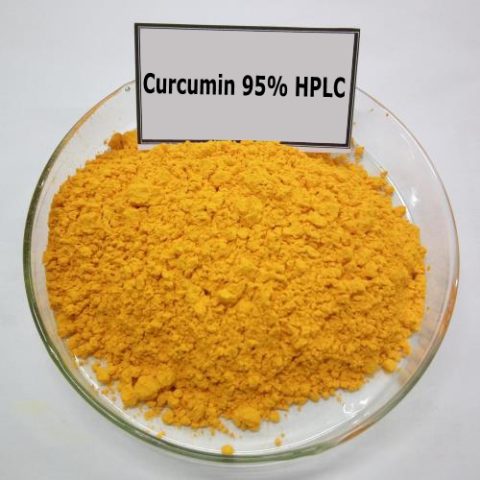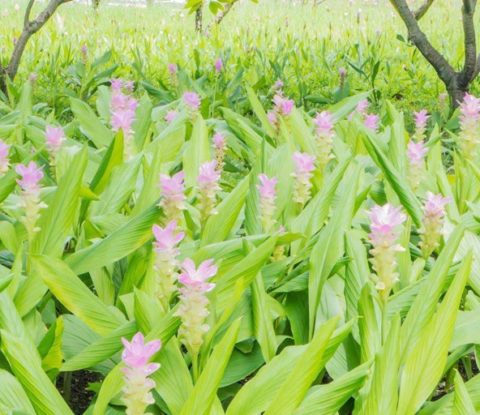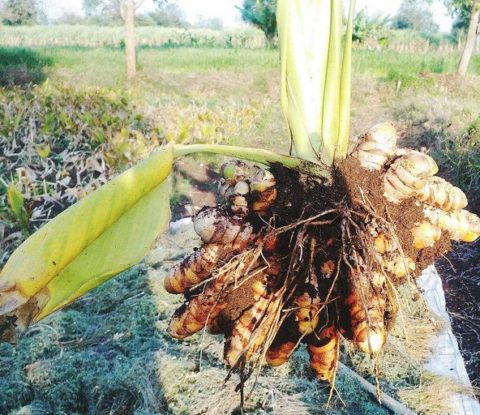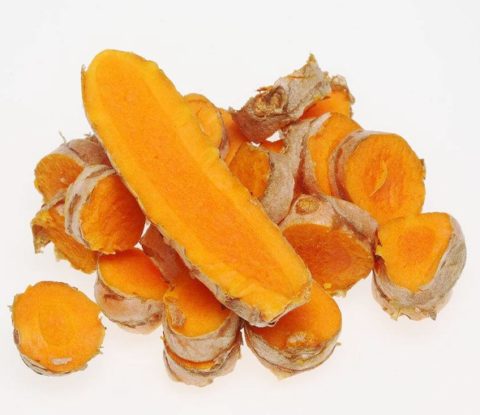
Curcumin 95% HPLC, Turmeric Root Extract Powder
Curcumin is orange yellow crystalline powder, slightly bitter and insoluble in water. It is mainly used for colouring intestinal products, cans, sauce and brine products in food production. Medical research shows that curcumin has the functions of lowering blood lipid, anti-tumor, anti-inflammatory, cholagogic and anti-oxidation.
Turmeric Root Extract Powder Curcumin 95% HPLC
【Latin Name】: Curcuma longa L
【Other Names】: Jiang Huang, Rhizoma Curcumae Longae, Tumeric, Common Turmeric Rhizome
【Appearance】: Orange yellow Powder
【part used】: Root
【Active Ingredient】: Curcumin
【Specification】: 95% HPLC, 10:1, 20:1TLC
【CAS No.】: 458-37-7
【Molecular formula】: C21H20O6
【Molecular weight】: 368.38
【Storage】: Store in cool dry place and keep from direct light
【Shelf life】: 2 years when properly stored
【Packing】: Fiber drum (25kg/drum); aluminum foil bag and carton box(less than 10kg)
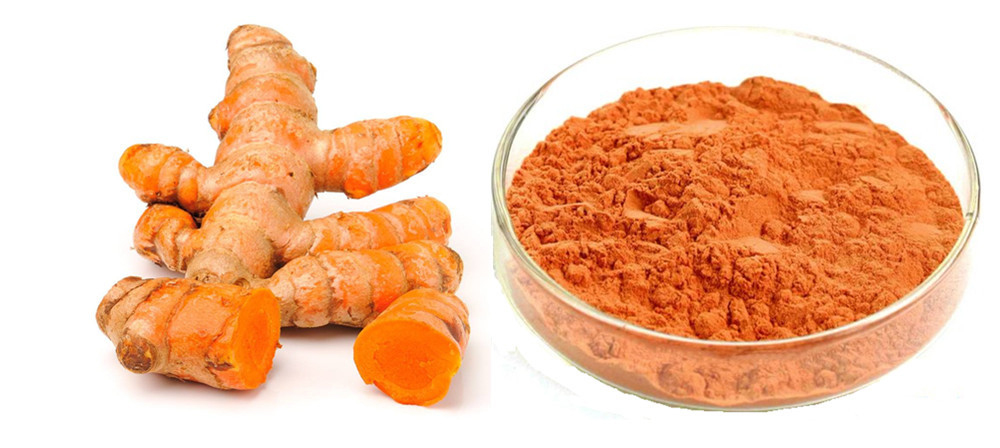
Curcumin: Turmeric is a rhizomatous herbaceous perennial plant of the ginger family, Zingiberaceae. It is native to tropical Tamilnadu, in southeast India, and needs temperatures between 20 °C and 30 °C (68 °F and 86 °F) and a considerable amount of annual rainfall to thrive. Plants are gathered annually for their rhizomes, and propagated from some of those rhizomes in the following season.
Its active ingredient is curcumin and it has a distinctly earthy, slightly bitter, slightly hotpeppery flavor and a mustardy smell. Curcumin has been a centre of attraction for potential treatment of an array of diseases, includingcancer, Alzheimer’s disease, diabetes, allergies, arthritis and other chronic illnesses.
Curcumin is the yellow pigment associated with the curry spice, Turmeric, and to a lesser extent Ginger. It is a small molecule that is the prototypical ‘curcuminoid’, and has effects similar to other polyphenols but unique in a way as it is a different class of polyphenol (relative to the other classes of ‘flavonoid’, ‘stilbene’, etc.)
It exerts potent anti-inflammatory effects, and these anti-inflammatory effects seem to be quite protective against some form of cancer progression. However, curcumin has additional anti-cancer effects that are independent of its anti-inflammatory effects and thus is a heavily researched molecule for both cancer prevention and treatment.
Other areas of interest as it pertains to curcumin are alleviating cognitive decline associated with aging, being heart healthy by both electrical means and reducing lipid and plaque levels in arteries, and both reducing the risk of diabetes and being a good treatment for the side-effects associated with diabetes.
It has a poor oral bioavailability (a low percentage of what you consume is absorbed) and thus should be enhanced with other agents such as black pepper extract, called piperine. This is unless you want the curcumin in your colon (as it is a colon anti-inflammatory and can help with digestion), in which case you wouldn’t pair it with an enhancement.
Doses up to 8g curcuminoids in humans have been shown to not be associated with much adverse effects at all, and in vitro tests suggest curcumin has quite a large safety threshold.
Indications in TCM (Traditional Chinese Medicine)
1.Pain of heart, chest, hypochondria and abdomen due to qi stagnation and blood stasis
This herb has the actions of activating blood, moving qi and alleviating pain. It is indicated for pain of heart, chest, hypochondria and abdomen due to qi stagnation and blood stasis, traumatic injuries, swollen and pain due to stasis, and gynecological diseases such as mass, amenorrhea, dysmenorrhea, irregular menstruation, postpartum abdominal pain and so on. In addition, it can activate blood and dissolve stasis, relieve carbuncle and swelling, and alleviate pain, so it is externally indicated for sores, abseess, carbuncle and swelling. For pain of heart and abdomen caused by qi stagnation and blood stasis, it is combined with blood-activating and qi-moving analgesics such as Dang Gui, Mu Xiang and Wu Yao, etc. For dysmenorrhea, amenorrhea and postpartum abdominal pain due to qi stagnation and blood stasis, it is combined with Dang Gui, Chuan Xiong and Hong Hua in Jiang Huang San from Sheng Ji Zong Lu. For traumatic injuries, swollen and pain due to stasis, it is combined with Su Mu, Ru Xiang and Mo Yao in Jiang Huang Tang from Shang Ke Fang Shu (Book on Traumatologic Prescription).
2. Wind-damp arthralgia
This herb is pungent with actions of dispersing and warming to achieve dredging action. It can dispel wind-cold-damp pathogens externally, move qi and blood internally, dredge meridians and activate collaterals, excelling at dredging arms and limbs to relieve arthralgia. For shoulder and arm pain, and wind-cold-damp arthralgia, it is usually combined with wind-damp-dispelling herbs and blood-activating herbs such as Qiang Huo, Fang Feng and Dang Gui.
Modern Researches on Its Pharmacological Effects
1. Implications in Cancer Metabolism
1). General (Not mechanisms)
Curcumin has the ability to protect DNA from oxidation via the heavy metal arsenic(Kinoshita A, et alCarcinogenicity of dimethylarsinic acid in Ogg1-deficient mice . Cancer Sci. (2007)), and this protection has been demonstrated in human trials after oral ingestion 1g of a 20:1 curcumin:piperine (Black Pepper) combination for 3 months(Biswas J, et al Curcumin protects DNA damage in a chronically arsenic-exposed population of West Bengal . Hum Exp Toxicol. (2010)). Blood lymphocytes were the biomarker for DNA damage.
In rats fed a low dose of curcumin (0.03% of the diet), curcumin was able to prevent formation of adducts in hepatic DNA induced by an injection of the carcinogenic benzo(a)pyrene(Mukundan MA, et alEffect of turmeric and curcumin on BP-DNA adducts . Carcinogenesis. (1993)). Curcumin also prevented adducts in colonic cells when administered at 2% of the diet with meals(Sharma RA, et al Effects of dietary curcumin on glutathione S-transferase and malondialdehyde-DNA adducts in rat liver and colon mucosa: relationship with drug levels . Clin Cancer Res. (2001)).
2). General (Mechanisms)
One of the mechanisms under investigation for chemoprotective effects of curcumin is the inhibitory effect on NF-kB, a protein that can influence genetic coding and transcription when activated. Normally, TNF-a (a pro-inflammatory cytokine) positively influences NF-kB activity and induces cell growth, survival, and inflammation. Curcumin can inhibit the interaction between the two molecules without reducing TNF-a levels, and aside from the inhibition of cytoprotection the elevated levels of TNF-a can induce cellular death via Fas-associated protein cell death and caspase-8(Bhattacharyya S, et al Tumor-induced oxidative stress perturbs nuclear factor-kappaB activity-augmenting tumor necrosis factor-alpha-mediated T-cell death: protection by curcumin . Cancer Res. (2007)). This mechanism appears to ‘sensitize’ cells to cell death induced by TNF-a by inhibiting cellular survival via NF-kB and is most likely due to curcumin’s ability to prevent or reduce activation of p38 in the face of other activators.
Curcumin is also able to suppress a transcription factor associated with NF-kB, the Notch family of proteins; this potentiates the suppressive effects on NF-kB, but Notch-1 overexpression is able to act in reverse and attenuate curcumin’s suppressive effects on NF-kB. Other notable products downstream of NF-kB that are reduced by curcumin administration are cyclooxygenase-2 (COX-2), cyclin D1, adhesion molecules, MMPs, inducible nitric oxide synthase, Bcl-2, Bcl-xL, and tumor necrosis factor (TNF); most of which are associated with cancer metabolism in some manner. Curcumin appears to directly inhibit IKKβ as the method of reducing NF-kB translocation.
A second possible molecular target for curcumin is the family of proteins known as Specificity Proteins, which include Sp1, Sp3, and Sp4. These proteins are transcription factors involved in cell growth regulation and survival. 10-25uM of curcumin in vitro was shown to decrease levels of all three of these proteins in a culture of bladder cells which ultimately led to cell death. The mechanism of action for curcumin was not fully elucidated, but at least partially involved stimulating proteosomal degradation of these transcription factors(Chadalapaka G1, et al Curcumin decreases specificity protein expression in bladder cancer cells . Cancer Res. (2008)).
3). Prostate Cancer
Secondary to inhibiting expression of the cytokines CXCL1 and CXCL2 (a downstream effect of NF-kB translocation inhibition), curcumin appears to negatively regulate several factors that can lead to prostatic tumor meta-stasis (COX2, SPARC and EFEMP) which can lead to less metastasis in vivo. As siRNA inhibition of CXCL1/2 also had these effects, this appears to be the metabolic lever of concern(Curcumin Inhibits Prostate Cancer Metastasis in vivo by Targeting the Inflammatory Cytokines CXCL1 and -2).
4). Bladder Cancer
Curcumin was able to arrest bladder cell cancer growth in vitro at concentrations of 10-25uM and induce apoptosis. This effect was also seen in an in vivo xenograft experiment where bladder cancer cells were transplanted into mice which were then given 50mg/kg injections of curcumin every other day for 18 days; this treatment also led to a reduction in tumor growth(Chadalapaka G1, et al Curcumin decreases specificity protein expression in bladder cancer cells . Cancer Res. (2008)).
2. Turmeric Dramatically Increases The Antioxidant Capacity of The Body
Oxidative damage is believed to be one of the mechanisms behind aging and many diseases. It involves free radicals, highly reactive molecules with unpaired electrons. Free radicals tend to react with important organic substances, such as fatty acids, proteins or DNA. The main reason antioxidants are so beneficial, is that they protect our bodies from free radicals. Curcumin happens to be a potent antioxidant that can neutralize free radicals due to its chemical structure (Menon VP, et al Antioxidant and anti-inflammatory properties of curcumin. Adv Exp Med Biol. 2007).
But curcumin also boosts the activity of the body’s own antioxidant enzymes (Rakhi Agarwal, et alDetoxification and antioxidant effects of curcumin in rats experimentally exposed to mercury. Journal of Applied Toxicology, Volume 30, Issue 5, pages 457–468, July 2010). In that way, curcumin delivers a one-two punch against free radicals. It blocks them directly, and then stimulates the body’s own antioxidant mechanisms.
3. Curcumin Boosts Brain-Derived Neurotrophic Factor, Linked to Improved Brain Function and a Lower Risk of Brain Diseases
Back in the day, it was believed that neurons weren’t able to divide and multiply after early childhood. However, it is now known that this does happen. The neurons are capable of forming new connections, but in certain areas of the brain, they can also multiply and increase in number. One of the main drivers of this process is Brain-Derived Neurotrophic Factor (BDNF), which is a type of growth hormone that functions in the brain. Many common brain disorders have been linked to decreased levels of this hormone. This includes depression and Alzheimer’s disease (Eiji Shimizu, et al Alterations of serum levels of brain-derived neurotrophic factor (BDNF) in depressed patients with or without antidepressants. Biological Psychiatry 2003).
Interestingly, curcumin can increase brain levels of BDNF (Ying Xu, et al Curcumin reverses the effects of chronic stress on behavior, the HPA axis, BDNF expression and phosphorylation of CREB. Brain Research 2006). By doing this, it may be effective at delaying or even reversing many brain diseases and age-related decreases in brain function. There is also the possibility that it could help improve memory and make you smarter. Makes sense given its effects on BDNF levels, but this definitely needs to be tested in human controlled trials (Muaz Belviranlı, et al Curcumin improves spatial memory and decreases oxidative damage in aged female rats. Biogerontology 2013).
